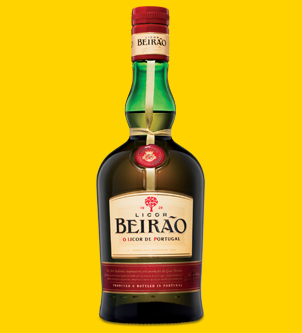
A liqueur is an alcoholic drink composed of spirits and additional flavorings such as sugar, fruits, herbs, and spices. Often served with or after dessert, they are typically heavily sweetened and un-aged beyond a resting period during production, when necessary, for their flavors to mingle.

Triple sec is an orange-flavoured liqueur that originated in France. It usually contains 20–40% alcohol by volume.

Sloe gin is a British red liqueur made with gin and blackthorn fruits (sloes), which are the drupe fruit of the Prunus spinosa tree, which is a relative of the plum. As an alcoholic drink, sloe gin contains between 15 per cent and 30 per cent alcohol by volume (ABV); however, European Union regulations established 25 per cent ABV as the minimal alcoholic content for the blackthorn beverage to be a sloe gin. Historically, despite being a liqueur based upon gin, the EU included the colloquial name sloe gin to the legal definitions; thus, sloe gin is the only alcoholic beverage that legally uses the term gin without appending the liqueur suffix.
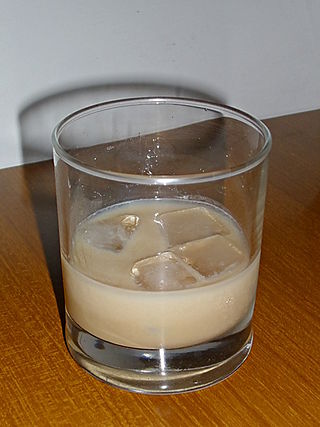
A cream liqueur is a liqueur that includes dairy cream and a generally flavourful liquor among its ingredients.

Grand Marnier is a French brand of liqueurs. The brand's best-known product is Grand Marnier Cordon Rouge, an orange-flavored liqueur created in 1880 by Alexandre Marnier-Lapostolle. It is made from a blend of Cognac brandy, distilled essence of bitter orange, and sugar, containing 40% alcohol. It is commonly consumed "neat" as a cordial or a digestif, and can be used in mixed drinks and desserts. Popular examples of the latter include crêpes Suzette and crêpes au Grand Marnier.

Amaretto is a sweet Italian liqueur that originated in Saronno. Depending on the brand, it may be made from apricot kernels, bitter almonds, peach stones, or almonds, all of which are natural sources of the benzaldehyde that provides the almond-like flavour of the liqueur. It generally contains 21 to 28 percent alcohol by volume.
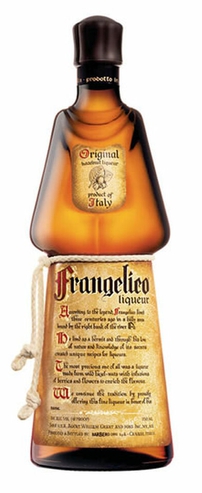
Frangelico is a brand of noisette and herb-flavored liqueur coloured with caramel coloring, which is produced in Canale, Italy. It is 20% alcohol by volume (ABV) or 40 proof. Formerly, it was 24% ABV or 48 proof. When produced by the Barbaro family it was bottled at 28% ABV or 56 proof. The brand was created in 1978. It is known for its unusual packaging; its bottle was designed to look like a Christian friar, complete with a knotted white cord around the waist. It is most commonly sold in two sizes: 750ml and 375ml.
Limoncello is an Italian lemon liqueur mainly produced in southern Italy, especially in the region around the Gulf of Naples, the Amalfi Coast, and Sicily. It is the second-most popular liqueur in Italy and is traditionally served chilled as an after-dinner digestivo. It is also a popular homemade liqueur, with various recipes available online and in print.
Curaçao is a liqueur flavored with the dried peel of the bitter orange laraha, a citrus fruit grown on the Caribbean island of Curaçao.
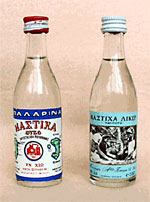
Mastika or mastiha is a liqueur seasoned with mastic, a resin with a slightly pine or cedar-like flavor gathered from the mastic tree, a small evergreen tree native to the Mediterranean region. In Greece, mastiha or mastichato is a sweet liqueur produced with the mastika resin from the Greek island of Chios, which is distilled after hardening to crystals. Sugar is typically added. It is a sweet liqueur that is typically consumed at the end of a meal. It has a distinctive flavor, reminiscent of pine and herbs. It is claimed to have medicinal properties and to aid digestion.
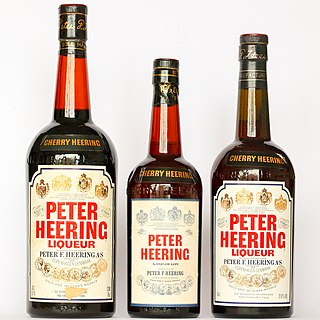
Heering Cherry Liqueur is a Danish liqueur flavored with cherries. It is often referred to simply as Peter Heering or Cherry Heering in cocktail recipes. Heering Cherry Liqueur has been produced since 1818, and the company is purveyor to the Royal Danish Court and formerly to Queen Elizabeth II. It is sold in more than 100 countries.

Bénédictine is a herbal liqueur produced in France. It was developed by wine merchant Alexandre Le Grand in the 19th century, and is flavored with twenty-seven flowers, berries, herbs, roots, and spices.
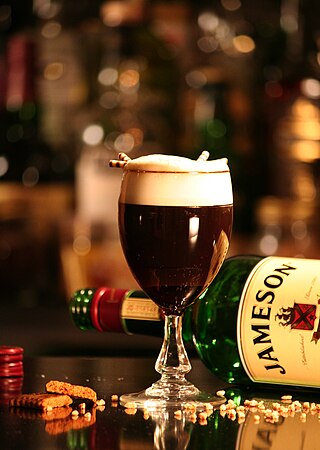
A liqueur coffee is a caffeinated alcoholic drink that consists of a shot of liqueur, mixed with coffee. It is typically served in a liqueur glass, often accompanied with cream and sugar. Coffee liqueur beverages are served in different fashions and can be found throughout many countries. One of the most popular liqueur coffee beverage is commonly known as Irish coffee. Liqueur coffee beverages are largely classified as cocktails as well as digestifs which are aimed at aiding the digestive process typically after a meal.

Licor 43, or Cuarenta y Tres, is a Spanish liqueur, made in Cartagena, Spain.
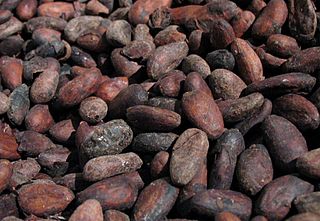
Chocolate liqueur is a chocolate flavored liqueur made from a base liquor of whisky or vodka. Unlike chocolate liquor, chocolate liqueur contains alcohol. Chocolate liqueur is often used as an ingredient in mixology, baking, and cooking.
Sassolino, sometimes called Sassolino di Modena, is an anise-flavored liqueur from Sassuolo, Italy. Its flavor is derived from star anise.
Crème de banane is a sweet, banana-flavored liqueur, usually bottled at 17–25% ABV. It is mostly used in alcoholic drinks but also in cooking; it is an ingredient of various cocktails and desserts.

Glayva is a liqueur originally produced in 1947 in Leith, Edinburgh, Scotland by Ronald Morrison & Co Ltd and now by Whyte and Mackay Ltd.
Irish Mist is an Irish whiskey-based liqueur produced in Tullamore, Ireland, by the Irish Mist Liqueur Company Ltd. In September 2010 it was announced that the brand was being bought by Gruppo Campari from William Grant, only a few months after Grants had bought it from the C&C Group. It is made from aged Irish whiskey, heather and clover honey, aromatic herbs, and other spirits, blended to an ancient recipe claimed to be 1,000 years old. Though it was once 40% alcohol per volume, Irish Mist is now 35%. The bottle shape has also been changed from a "decanter" style to a more traditional whiskey bottle shape. It is currently available in more than 40 countries.














